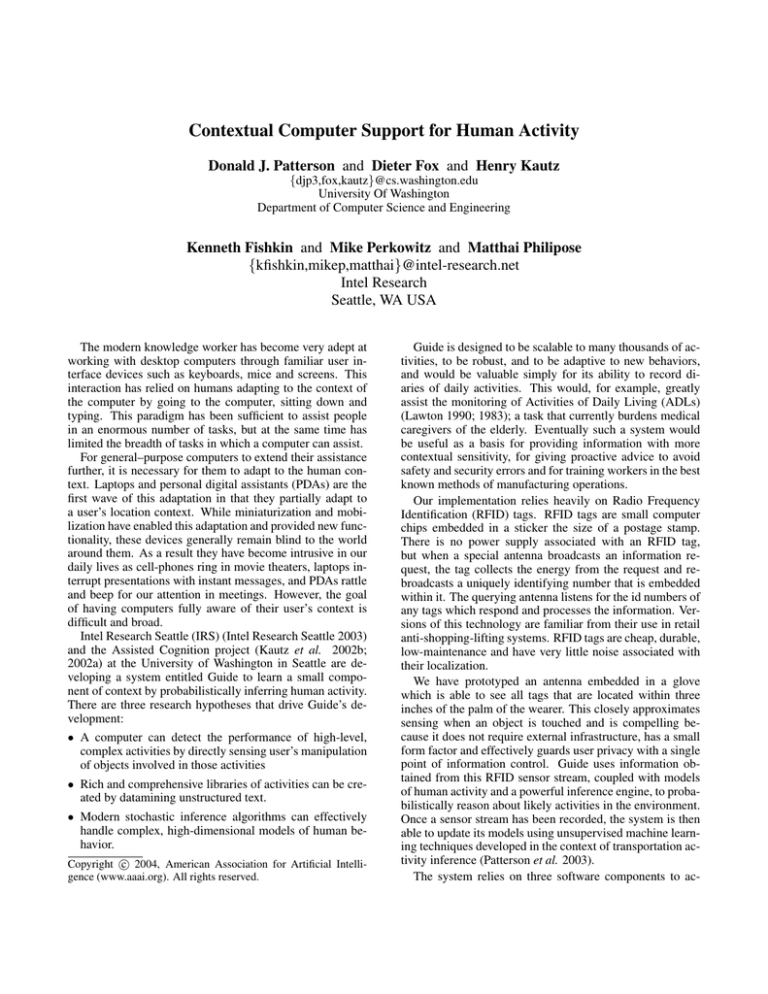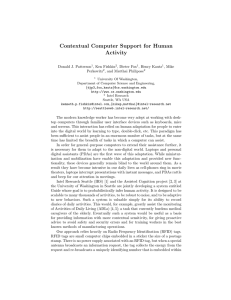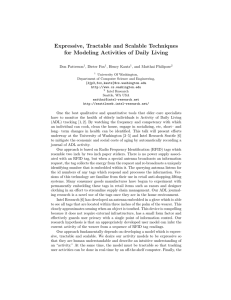
Contextual Computer Support for Human Activity
Donald J. Patterson and Dieter Fox and Henry Kautz
{djp3,fox,kautz}@cs.washington.edu
University Of Washington
Department of Computer Science and Engineering
Kenneth Fishkin and Mike Perkowitz and Matthai Philipose
{kfishkin,mikep,matthai}@intel-research.net
Intel Research
Seattle, WA USA
The modern knowledge worker has become very adept at
working with desktop computers through familiar user interface devices such as keyboards, mice and screens. This
interaction has relied on humans adapting to the context of
the computer by going to the computer, sitting down and
typing. This paradigm has been sufficient to assist people
in an enormous number of tasks, but at the same time has
limited the breadth of tasks in which a computer can assist.
For general–purpose computers to extend their assistance
further, it is necessary for them to adapt to the human context. Laptops and personal digital assistants (PDAs) are the
first wave of this adaptation in that they partially adapt to
a user’s location context. While miniaturization and mobilization have enabled this adaptation and provided new functionality, these devices generally remain blind to the world
around them. As a result they have become intrusive in our
daily lives as cell-phones ring in movie theaters, laptops interrupt presentations with instant messages, and PDAs rattle
and beep for our attention in meetings. However, the goal
of having computers fully aware of their user’s context is
difficult and broad.
Intel Research Seattle (IRS) (Intel Research Seattle 2003)
and the Assisted Cognition project (Kautz et al. 2002b;
2002a) at the University of Washington in Seattle are developing a system entitled Guide to learn a small component of context by probabilistically inferring human activity.
There are three research hypotheses that drive Guide’s development:
• A computer can detect the performance of high-level,
complex activities by directly sensing user’s manipulation
of objects involved in those activities
• Rich and comprehensive libraries of activities can be created by datamining unstructured text.
• Modern stochastic inference algorithms can effectively
handle complex, high-dimensional models of human behavior.
c 2004, American Association for Artificial IntelliCopyright gence (www.aaai.org). All rights reserved.
Guide is designed to be scalable to many thousands of activities, to be robust, and to be adaptive to new behaviors,
and would be valuable simply for its ability to record diaries of daily activities. This would, for example, greatly
assist the monitoring of Activities of Daily Living (ADLs)
(Lawton 1990; 1983); a task that currently burdens medical
caregivers of the elderly. Eventually such a system would
be useful as a basis for providing information with more
contextual sensitivity, for giving proactive advice to avoid
safety and security errors and for training workers in the best
known methods of manufacturing operations.
Our implementation relies heavily on Radio Frequency
Identification (RFID) tags. RFID tags are small computer
chips embedded in a sticker the size of a postage stamp.
There is no power supply associated with an RFID tag,
but when a special antenna broadcasts an information request, the tag collects the energy from the request and rebroadcasts a uniquely identifying number that is embedded
within it. The querying antenna listens for the id numbers of
any tags which respond and processes the information. Versions of this technology are familiar from their use in retail
anti-shopping-lifting systems. RFID tags are cheap, durable,
low-maintenance and have very little noise associated with
their localization.
We have prototyped an antenna embedded in a glove
which is able to see all tags that are located within three
inches of the palm of the wearer. This closely approximates
sensing when an object is touched and is compelling because it does not require external infrastructure, has a small
form factor and effectively guards user privacy with a single
point of information control. Guide uses information obtained from this RFID sensor stream, coupled with models
of human activity and a powerful inference engine, to probabilistically reason about likely activities in the environment.
Once a sensor stream has been recorded, the system is then
able to update its models using unsupervised machine learning techniques developed in the context of transportation activity inference (Patterson et al. 2003).
The system relies on three software components to ac-
complish this, a data miner, an activity inference engine
and a visualizer. The data mining component is critical to
achieving scalability of the system. Given the wide range
of human activity it would be problematic to require an expert to generate a model of every interesting activity that a
person could perform. Instead we model ordered compound
activities by mining “how-to” sites (e.g, (All Recipes 2003;
eHow Inc. 2003)) and interpret the textual order of the steps
as sequential constraints. We augment these sequential models with prior probabilities of object touches, given an activity, by leveraging features of the Google programming API
(Google Labs 2003). To date, we have mined the sequential
structure of roughly fifteen thousand activities.
The activity inference engine accepts the models from the
data miner, converts them to Dynamic Bayesian Networks
(Murphy 2002) and uses particle filters (Fox et al. 2001;
Doucet, de Freitas, & Gordon 2001) to infer activities given
an RFID sensor stream. The visualizer gives insight into
the reasoning process by showing how the sensors affect the
inference engine’s belief state and allow a user to improve
and debug the generated models. By using ExpectationMaximization the activity inference engine also has the capability to learn model parameters in an unsupervised manner.
As a preliminary experiment we asked 14 individuals to
wear the RFID glove and perform ADLS in a home instrumented with RFID tags. We asked each subject to accomplish 12 out of 14 goals in the way that they normally would
and record the sequence. Example goals included making a
snack, making a hot beverage, and taking care of personal
appearance. Under these circumstances and using handmade models, the system performs well, correctly recognizing goals with 88% precision and 73% recall. (Philipose et
al. 2003)
As we continue to integrate and extend the components of
our system, we are actively seeking input about how to best
support the proactive software components that we regard as
the consumers of our reasoning. Understanding the applications and needs of these components will further drive our
research agenda and inform our development efforts.
References
All Recipes.
2003.
All Recipes website.
http://www.allrecipes.com/.
Doucet, A.; de Freitas, N.; and Gordon, N., eds. 2001.
Sequential Monte Carlo in Practice. New York: SpringerVerlag.
eHow Inc. 2003. eHow website. http://www.ehow.com/.
Fox, D.; Thrun, S.; Dellaert, F.; and Burgard, W. 2001. Particle filters for mobile robot localization. In Doucet et al.
(2001).
Google Labs.
2003.
Google Web APIs.
http://www.google.com/apis/.
Intel Research Seattle. 2003. Intel Research Seattle Guide Project Website.
http://seattleweb.intelresearch.net/projects/guide/.
Kautz, H.; Arnstein, L.; Borriello, G.; Etzioni, O.; and Fox,
D. 2002a. The Assisted Cognition Project. In Proceedings
of UbiCog ’02: First International Workshop on Ubiquitous Computing for Cognitive Aids.
Kautz, H.; Fox, D.; Etzioni, O.; Borriello, G.; and
Arnstein, L.
2002b.
An Overview of the Assisted Cognition Project. http://www.cs.washington.edu/
homes/kautz/ac/acaaai02.pdf.
Lawton, M. P. 1983. Environment and Other Determinants of Well-Being in Older People. The Gerontologist
23(4):349–357. NLM:0375327;PMID:6352420.
Lawton, M. P.
1990.
Aging and Performance
of Home Tasks.
Human Factors 32(5):527–536.
NLM:0374660;PMID:2074107.
Murphy, K. 2002. Dynamic Bayesian Networks: Representation, Inference and Learning. Ph.D. Dissertation, UC
Berkeley, Computer Science Division.
Patterson, D. J.; Liao, L.; Fox, D.; and Kautz, H. 2003. Inferring High-Level Behavior from Low-Level Sensors. In
Proceedings of UBICOMP 2003: The Fifth International
Conference on Ubiquitous Computing.
Philipose, M.; Fishkin, K.; Perkowitz, M.; Patterson,
D.; and Hähnel, D. 2003. The Probabilistic Activity Toolkit: Towards Enabling Activity-Aware Computer Interfaces. Technical report, Intel Research Seattle. http://www.cs.washington.edu/homes/djp3/AI/ AssistedCognition/publications /Intel/irs tr 03 013.doc.







